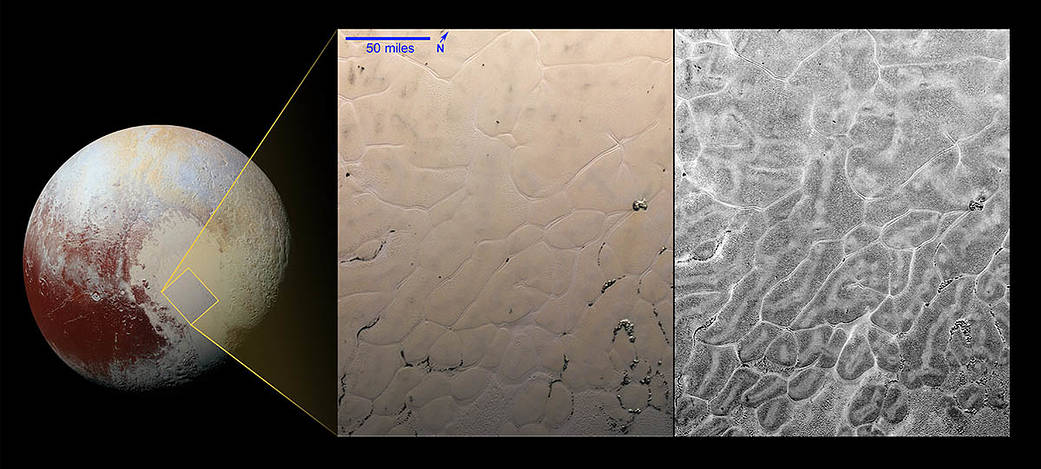The vast nitrogen ice plains of Pluto’s informally named Sputnik Planum – the western half of Pluto’s “heart” – are giving up more secrets.
Scientists on NASA’s New Horizons mission have processed images of Sputnik Planum to bring out intricate, never-before-seen patterns in the surface textures of these glacial plains. The left inset on the image (above) shows an enhanced-color close-up of a region of cellular plains in the middle of Sputnik. The right-hand inset is a “scattering map” of the same region. The scattering map is created by combining two images of Sputnik Planum that were taken at two very different viewing geometries (angles) as the New Horizons spacecraft flew past. Bright regions on the scattering image preferentially reflect sunlight forward, away from the direction of the sun, probably because they have a relatively smooth texture. Conversely, darker regions in the scattering map tend to reflect sunlight back toward the sun, probably because they have a rougher texture. This new and valuable view of the plains reveals distinct, intricate patterns within the cells that were not evident before.
The scattering map reveals that, with some exceptions, the centers of cells tend to be smoother, while their edges tend to be rougher and more pitted. The boundaries between ice cells in many cases tend to be even brighter and hence smoother than the cell centers. This pattern is very likely a consequence of the convective flow that New Horizons scientists think is taking place within the nitrogen ice of Sputnik Planum, where warmer ice rises at the centers of cells, travels outward, and descends at the edges, like a cosmic lava lamp. Exactly how this process contributes to the surface texture patterns in the cells is a mystery. Smooth plains are occasionally seen to stretch across cell boundaries, which may indicate that the convective system is unstable and constantly evolving, with cells likely splitting apart and recombining.
New Horizons’ Ralph/Multispectral Visible Imaging Camera (MVIC) obtained all the data used to create these images. The colorized left inset uses an image with a resolution of approximately 2,230 feet (680 meters) per pixel, obtained at a range of about 21,060 miles (33,900 kilometers) from Pluto, about 44 minutes before closest approach on July 14, 2015. Two images were used to create the scattering map: the resolution of the first is approximately 1,620 feet (495 meters) per pixel, and it was obtained at a range of some 15,380 miles (24,750 kilometers) from Pluto, about 29 minutes before closest approach. The resolution of the second is approximately 1,050 feet (320 meters) per pixel, and it was obtained at a range of about 9,940 miles (16,000 kilometers) from Pluto, about 18 minutes before closest approach.
Credits: NASA/JHUAPL/SwRI





























